Abstract
RAPD (random amplification of polymorphic DNA) was used to distinguish the genetic diversities between two genera of Chrysopa and Chrysoperla (Neuroptera, Chrysopidae). Sixty specimens were collected in different places in Kermanshah, west of Iran. The wing venation was used for identification of each type of two genera, and the gender was determined by study of external genitalia. 20 random primers were used for polymerase chain reaction. Then, the electrophoresis was used for separation of the PCR products on agarose gel. 294 bands were amplified, which 235 bands were polymorph and others (59s) determined as monomorph. The electrophoresis results showed that the primers OPA02 with 19 bands and OPA03 with 8 bands successively amplified the maximum and minimum of bands among the applied primers. The results showed that there are maximum of genetic diversity and minimum of genetic similarity between Chrysopa male (Chrysopa-M) and Chrysoperla female)Chrysoperla-F) population, in contrast, there are maximum of genetic similarity and minimum of genetic diversity between Chrysoperla-M and Chrysoperla-F, and Chrysopa-M and Chrysopa-F. There are also more genetic similarities, between males and females of Chrysopa and Chrysoperla, than between male of Chrysopa with female of Chrysoperla or vice versa.






Similar content being viewed by others
References
Winterton S, De Freitas S (2006) Molecular phylogeny of the green lacewings (Neuroptera: chrysopidae). Aust J Entomol 45(3):235–243. doi:10.1111/j.1440-6055.2006.00537.x
Brooks SJ, Barnard PC (1990) The green lacewings of the world: a generic review (Neuroptera: Chrysopidae). Bull Br Museum (Natural History)
Henry CS, Wells MLM (2009) Sexually dimorphic intrasexual duetting in an otherwise monomorphic green lacewing (Neuroptera, Chrysopidae, Chrysoperla plorabunda): sexual selection or sex recognition? J Insect Behav 22(4):289–312. doi:10.1007/s10905-009-9174-3
Brooks SJ (1997) An overview of the current status of chrysopidae (Neuroptera) systematics. Deutsche Entomologische Zeitschrift 44(2):267–275. doi:10.1002/mmnd.19970440212
Lourenço P, Brito C, Backeljau T, Thierry D, Ventura MA (2006) Molecular systematics of the Chrysoperla carnea group (Neuroptera: Chrysopidae) in Europe. J Zool Sci 44(2):180–184
Kimura M, Crow JF (1964) The number of alleles that can be maintained in a finite population. Genetics 49:725–738
Nagaraju J, Reddy KD, Nagaraja GM, Sethuraman BN (2001) Comparison of multilocus RFLPs and PCR-based marker systems for genetic analysis of the silkworm, Bombyx mori. Heredity (Edinb) 86(Pt 5):588–597
Lewontin RC (1974) The genetic basis of evolutionary change. Columbia University Press, New York, USA
Ghasempour HR, Kahrizi D, Mahdiah N (2007) New discussions in biotechnology. Razi University Press, Razi
Fleurat-Lessard1 F, Pronier V (2006) Genetic differentiation at the inter- and intra-specific level of stored grain insects using a simple molecular approach (RAPD). In: Proceedings of 9th international working conference on stored product protection. Sao-Polo, Brasil
Williams JG, Kubelik AR, Livak KJ, Rafalski JA, Tingey SV (1990) DNA polymorphisms amplified by arbitrary primers are useful as genetic markers. Nucleic Acids Res 18(22):6531–6535
Kahrizi D, Arminian A, Masumi AA (2007) In vitro plant breeding. Razi University Press, Razi
Lou KF, Weiss MJ, Bruckner PL, Morill WL, Talbert LE, Martin JM (1998) RAPD variation within and among geographic populations of wheat stem sawfly (Cephuscinctus Norton). J Hered 89(4):329–335
Zhou X, Faktor O, Applebaum SW, Coll M (2000) Population structure of the pestiferous moth Helicoverpa armigera in the Eastern Mediterranean using RAPD analysis. Heredity 85(3):251–256
Gadelhak GG, Enan MR (2005) Genetic diversity among populations of red palm weevil, Rhynchophorus ferrugineus olivier (Coleoptera: curculionidae), determined by random amplified polymorphic DNA polymerase chain reaction (RAPD-PCR). Int J Agric Biol 7(3):395–399
Helmi A, Khafaga AF (2011) Molecular fingerprinting of certain cereal aphids in Egypt (Hemiptera: Sternorhyncha, Aphididae) using RAPD and ISSR markers and A. F. Khafaga. J Entomol 8(4):327–340
Aspöck H, Aspöck U, Hölzel H (1980) Die Neuropteren Europas. Spektrum Akademischer Verlag, German
Li G, Quiros CF (2001) Sequence-related amplified polymorphism (SRAP), a new marker system based on a simple PCR reaction:its application to mapping and gene tagging in Brassica. Theor Appl Genet 103:455–461
Botstein D, White RL, Skolnick M, Davis RW (1980) Construction of a genetic linkage map in man using restriction fragment length polymorphisms. Am J Hum Genet 32(3):314–331
Caterino MS, Cho S, Sperling FA (2000) The current state of insect molecular systematics: a thriving Tower of Babel. Annu Rev Entomol 45:1–54. doi:10.1146/annurev.ento.45.1.1
Swofford DL (1993) PAUP. Phylogenetic analysis using parsimony (and other methods). Massachusetts, Sunderland
Nei M (1973) Analysis of gene diversity in subdivided populations. Proc Nat Acad Sci USA 70(12):3321–3323
Author information
Authors and Affiliations
Corresponding author
Rights and permissions
About this article
Cite this article
Mirmoayedi, A., Kahrizi, D., Ebadi, A.A. et al. Study of individual and sex genetic diversity among each genus and between two genera of Chrysopa and Chrysoperla (Neuroptera, Chrysopidae) based on RAPD-PCR polymorphism. Mol Biol Rep 39, 8999–9006 (2012). https://doi.org/10.1007/s11033-012-1770-1
Received:
Accepted:
Published:
Issue Date:
DOI: https://doi.org/10.1007/s11033-012-1770-1




